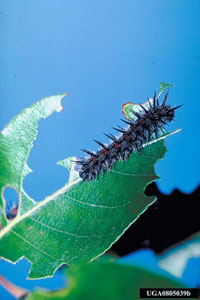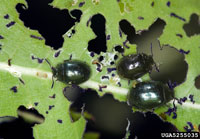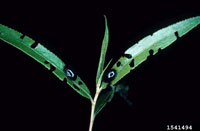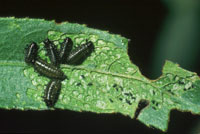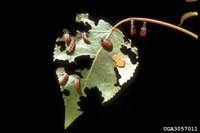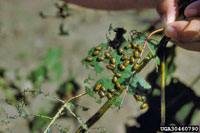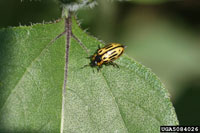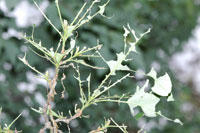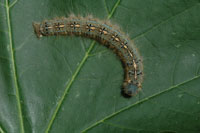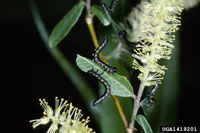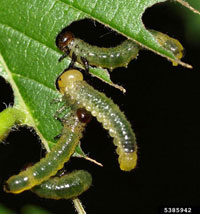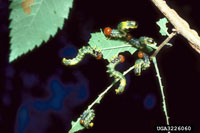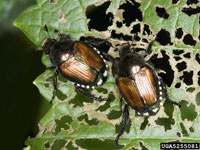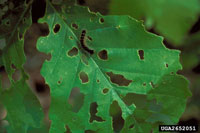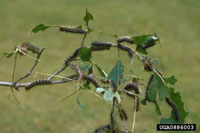Extension > Garden > Diagnose a problem > What's wrong with my plant? > Deciduous Trees > Willow > Holes in leaves or parts of leaves missing
Willow > Leaves > Holes in leaves or parts of leaves missing
1 of 8
Spiny elm caterpillar
Nymphalis antiopa
- Larvae feed in groups, eating leaves; they can defoliate entire branches
- Mostly black with scattered white spots and a single row of red spots and black spines along its body
- Larvae feed in May and June and again in July or August by a second generation
- Turn into mourning cloak butterflies
- More information on Spiny elm caterpillar
2 of 8
Imported willow leaf beetle
Plagiodera versicolora
- Adult beetles make notches or holes in leaves
- Larvae windowpane leaves, i.e. they feed on the upper surface of the leaves between the veins
- Prefers willows and poplars, especially weeping willow
- Adults are bluish-black to greenish blue, about ⅛ – ¼ inch long
- Larvae are dark, almost black and about ¼ inch long
- Yellow eggs on underside of leaves in May
- More information on Imported willow leaf beetle
3 of 8
Cottonwood leaf beetle
Chrysomela scripta
- Adults eat holes in leaves and along the margins
- Larvae windowpane feed, i. e. feed on the leaf surface between the veins
- Prefers willows, cottonwoods and other poplars
- Adults are ¼ inch long with yellow and black stripes
- Larvae are black with 2 white dots on either side
- More information on Cottonwood leaf beetle
4 of 8
Forest tent caterpillar
Malacosoma disstria
- Chews entire sections of leaves, often leaving some major veins; defoliation can be severe
- Hairs along sides of body, blue and black with characteristic footprint shaped white markings on top of body, almost 2 inches long when fully grown
- Occurs in May and June
- More information on Forest tent caterpillar
5 of 8
Willow sawfly
Nematus ventralis
- Larvae feed gregariously (in nonsocial groups)
- Young larvae feed on leaf edges and consume entire leaves as they get older
- Larvae are greenish black to black with black head and large yellow spots on sides; grow to ¾ inch long
- Two generations per year feeding in May and June and again July to September
- More information on Willow sawfly
6 of 8
Elm sawfly
Cimbex americana
- Larvae chew on leaf edges and consume entire leaves as they get older
- Full-grown larva has a wrinkled, 2 inch long body; it is pale yellowish to greenish with black stripe down its back with many small white spots
- Larvae present in June and feed until late July or August
- More information on Elm sawfly
7 of 8
Japanese beetle
Popillia japonica
- Skeletonizes leaves, i.e. chews leaf tissue between the veins creating a lacelike appearance
- Attacks are common in sunny locations starting at the top of the tree and working down as they feed
- Adults are a metallic green; bronze wings; 5 white tufts of "hair" along their sides and two white tufts on the tip of abdomen
- Beetles present from late June through September
- More information on Japanese beetle
8 of 8
Gypsy moth
Lymantria dispar
- Chew leaves and can defoliate trees
- Mature larvae are 2 inches long; upper side has five pairs of blue dots near front of body followed by six pairs of red dots down the back
- Damage occurs in June and July
- Is currently a federally quarantined pest in Minnesota; not established in Minnesota; if found, contact Arrest the Pest: 1-888-545-6684 or Arrest.the.Pest@state.mn.us
- More information on Gypsy moth



